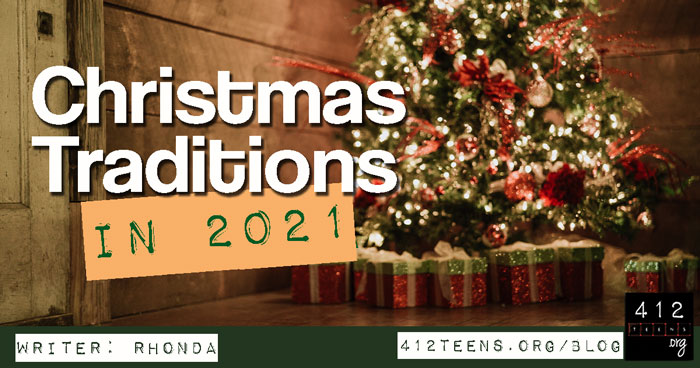Christmas Traditions in 2021

Posted by Rhonda on December 18, 2021
Christmas Eve has always been my favorite day of the year. In my family, Christmas Eve was a time of intentional family togetherness focusing on the true spirit of Christmas. We enjoyed decorating cookies for Santa and attending a candlelight service at church where the pastor read the story of a babe in a manger from Luke.
We would come home to open just one gift, put on our pajamas, and cuddle up with popcorn and hot chocolate while watching Elf. Lastly was a reading of The Night Before Christmas, all before an early bedtime. Then Santa got to work arranging stockings and gifts, taking nibbles from cookies and carrots (kind of a gross combination if you ask me), and jotting a note in red crayon for the kids commending their (mostly) good behavior over the past year.
This is just an example of one family’s practices. Christmas in America has become a beautiful amalgamation of traditions from around the world—many dating back to the first century and earlier. Many Christmas traditions are firmly rooted in celebration of the birth of Jesus. But some of our most treasured Christmas traditions have been adopted and adapted from multiple cultures and faith systems.
Take, for instance, the date we traditionally celebrate Christmas. The Bible makes no mention of Jesus’ birthday, nor are there any biblical references to the earliest Christians celebrating his birth. Some of the first documented Christmas festivals occurred during the reign of Constantine, a Roman ruler who converted to Christianity.
Elements of early Christmas celebrations that developed during this time may well derive from pagan traditions. Yet, the actual date might derive more from rabbinical and Christian traditions. The most-often touted theory of how we came to celebrate the birth of Jesus on December 25 is that the date was borrowed from the pagan celebration of Saturnalia. Other biblical scholars refer to early Christian writings to suggest Jesus was conceived on the same day he died—most likely March 25, with December 25 falling nine months later.
Several modern Christmas traditions hail from cultures and belief systems around the world. An early pagan tradition of lighting candles to ward off cold and evil spirits has been adopted and adapted by Christians who see Jesus as the Light of the World. Gift giving, originally a Druidic practice, has likewise been assimilated into Christmas celebrations. Christians consider Jesus a gift from God, and also seek to remember the Magi who brought gifts to the newborn Messiah.
Modern Christmas traditions that originated from other cultures:
- Decorated Christmas trees originated from Germany in the Middle Ages. Evergreen fir trees have long been used in winter celebrations (pagan and Christian). Christians see the trees as symbols of everlasting life.
- Burning Yule logs is a tradition that predates the birth of Jesus and Christianity. A log was burned on winter solstice to honor the sun god Odin—known as the Yule Father. As Christianity spread throughout Europe, the traditional Yule log was made part of Christmas celebrations and the Yule Father was replaced by Father Christmas. Today, Christians see the Yule log as a symbol of blessing and provision.
- Leaving cookies and milk for Santa dates back to Norse mythology. However, the practice became popular in America during the Great Depression as a sign of showing gratitude in times of struggle.
- Candy canes date back to 1670 Germany and likely were not intended as Christian symbols. Many Christians, however, see candy canes as the shape of a shepherd’s hook remembering the humble shepherds that heard the angelic announcement of Christ’s birth.
Distinct Christian Christmas traditions now popular in secular Christmas celebrations:
- Wreaths have been around since ancient Greek and Roman times, but the evergreen Christmas wreath adorned with boughs of holly demonstrate Christian meaning with the circular shape symbolizing eternal life and the holly leaves and berries representing Jesus’ crown of thorns. Today, made of a variety of materials and styles, wreaths are most often seen as a secular tradition.
- Saint Nicholas was a Christian bishop who helped the needy. After his death, the renown of his gift-giving grew. Saint Nicholas transformed into the legendary character we call “Santa Claus,” who brings Christmas presents to the good children of the world.
- "The Twelve Days of Christmas" in Christian tradition spans the birth of Jesus and the visit of the Magi, December 25 through January 6. The famous poem-turned-song dates back to 1780. Fun fact: In 2019, the PNC Christmas Price Index totaled up the cost of all 12 gifts of the song. The bill for a partridge in a pear tree to twelve drummers would run you $38993.59 as of 2019! Today, throw in masks, hand sanitizer, and plexiglass for all the pipers, lords, and dancers...and, well, the cost would go up significantly!
Regardless of how we each celebrate Christmas or which traditions mean the most to us, we can see that it isn’t the origins of the tradition that matter. Rather, what matters is the love and meaning behind those traditions that counts.
In 2020 and this year of 2021, many of us have faced holidays that look very different than in years’ past. Even without all of the holiday parties, feasts, in-person church services, family gatherings, Christmas still comes. Even if we don’t get the tree up, bake 300 cookies, or burn a Yule log, maybe this year we will grasp something Peanuts' Linus tried to teach us long ago when a disillusioned and depressed Charlie Brown asked, “Doesn’t anyone know what Christmas is all about?”
And there were in the same country shepherds abiding in the field, keeping watch over their flock by night. And, lo, the angel of the Lord came upon them, and the glory of the Lord shone round about them: and they were sore afraid.
And the angel said unto them, Fear not: for, behold, I bring you good tidings of great joy, which shall be to all people. For unto you is born this day in the city of David a Savior, which is Christ the Lord. And this shall be a sign unto you; Ye shall find the babe wrapped in swaddling clothes, lying in a manger.
And suddenly there was with the angel a multitude of the heavenly host praising God, and saying, Glory to God in the highest, and on earth peace, good will toward men.
That’s what Christmas is all about, Charlie Brown.*
—Rhonda
* Reference: Schultz, Charles. A Charlie Brown Christmas. CBS. 1965.


Writer: Rhonda Maydwell
Rhonda is an author, wife, mother, and mentor. She graduated from the University of Missouri with a degree in English and Religious studies. She loves studying God’s Word for truth and wisdom and uses it as a compass and roadmap for her own spiritual journey. Rhonda believes in sharing the Good News and the hope found in biblical truths with others. She uses her writing and mentoring opportunities (often with a pinch of humor) to do just that.
